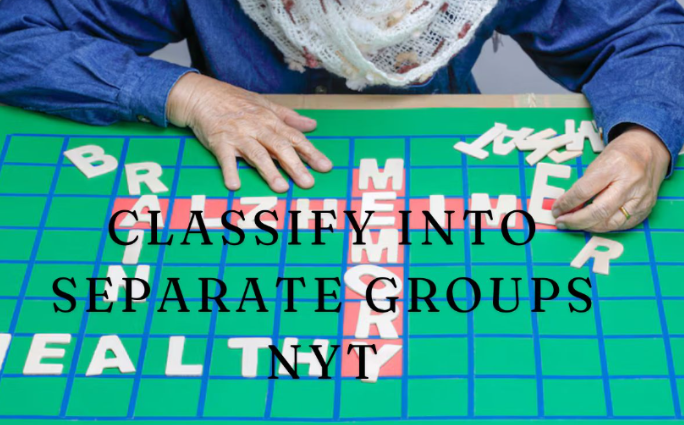How to Classify Into Separate Groups NYT: A Simple Guide

Classify into separate groups nyt is a way to organize things so they make sense. This helps us understand and find what we need quickly. For example, you can classify toys by color or size. When we put things into groups, it is easier to see how they are alike or different.
In this blog post, we will learn how to classify into separate groups effectively. We will explore different methods and examples to make grouping fun and simple. Whether you are organizing your toys, school supplies, or even ideas, these tips will help you a lot!
Why Is Classifying Important in Daily Life
Classifying is important because it helps us think clearly. When we group things, we can see patterns and connections. Here are some reasons why classifying is useful:
- Organization: Keeping things organized helps us avoid clutter. Whether it’s school supplies or kitchen items, a tidy space makes it easier to work.
- Problem Solving: When we face a problem, classifying the information can help us find a solution faster.
- Learning: Classifying helps us learn new information. For example, in reading, understanding the genre of a book can help us enjoy it more.
Classifying is not just for schoolwork. It can be used in our everyday lives. For example, you can classify your clothes by color or type. This way, getting dressed becomes a lot quicker and easier!
Simple Ways to Classify Items at Home
There are many fun and simple ways to classify items at home. Here are some ideas to try:
- By Size: You can group toys by size. Keep the big toys in one box and the small toys in another.
- By Color: Sort your crayons or markers by color. This makes it easy to find the color you want for your drawing.
- By Type: Put your books in different piles based on whether they are storybooks, picture books, or reference books.
When you classify items this way, you not only make your space tidy but also learn to think critically about how things are similar or different.
Fun Activities to Practice Classifying Items
Practicing classification can be fun! Here are some activities you can try:
- Nature Walk: Go outside and collect different leaves. When you get home, classify them by shape, size, or color.
- Cooking Time: While helping in the kitchen, classify ingredients. Group all fruits together and all vegetables together.
- Art Project: Create a collage using pictures from magazines. Classify the pictures by themes, like animals, food, or places.
These activities help you understand how to classify into separate groups in different situations. The more you practice, the better you will get at organizing your thoughts and items!
Final Thoughts: The Power of Classifying Items
Classifying items is a powerful skill that helps us in many areas of life. By learning how to classify into separate groups, we can stay organized, improve our problem-solving skills, and make learning more enjoyable.
In your daily life, remember to look for opportunities to group things. Whether you are at school, at home, or playing outside, think about how you can sort items. This will help you become a better organizer and thinker!
How to Classify Into Separate Groups Nyt in School Projects
Classifying into separate groups nyt is especially useful when working on school projects. When you organize your information well, it makes it easier for you and your classmates to understand the topic. Here are some steps to help you classify information effectively in your school projects:
Identify Main Topics
Before you start, think about the main topics of your project. What are you trying to learn or share? For example, if your project is about animals, you might want to classify them into groups like mammals, birds, and reptiles. Identifying main topics will help you create a strong foundation for your project.
Gather Information
Next, collect information related to each main topic. This could be facts, pictures, or even videos. When you gather information, keep it organized. Use folders or binders to separate information by topic. For example, keep all the information about mammals in one folder and all the information about reptiles in another. This makes it easy to find what you need later.
Create Visual Aids
Visual aids, like charts or posters, can help you present your project clearly. When you create a chart, classify your information visually. For example, you can make a chart that shows different animals in their groups. This helps your classmates see the information in a simple way.
- Charts: Draw a large chart with columns for each animal group.
- Posters: Create a poster with pictures of each animal in its group.
Visual aids make your project more engaging and fun to share with others!
Practice Presenting
Finally, practice presenting your project. When you explain how you classified the information, it will help others understand your work better. Use simple words and clear examples. For instance, if you classified animals, you can say, “I put all the animals that give birth to their young in one group, called mammals.” This makes it easy for your audience to follow along.
When you learn to classify into separate groups in your school projects, it helps you communicate your ideas better. Plus, it makes learning more enjoyable for everyone involved. Always remember, organizing your information is a key part of being successful in school!
Conclusion
In mastering the skill of classification is important for school and everyday life. When you classify into separate groups, you learn to organize your thoughts and items better. This helps you become more efficient and confident in your abilities.
So, next time you have a school project or need to organize your things at home, think about how you can classify items. This simple skill can make a big difference in how you learn and interact with the world around you!




